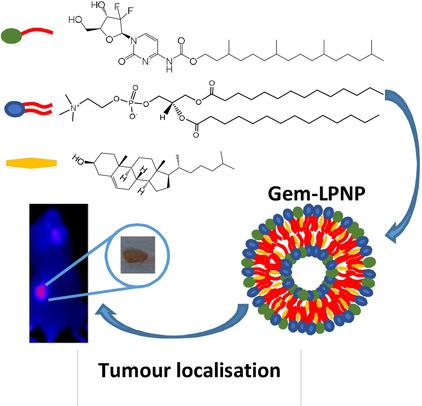当前位置:
X-MOL 学术
›
ChemPlusChem
›
论文详情
Our official English website, www.x-mol.net, welcomes your
feedback! (Note: you will need to create a separate account there.)
Biomimetic Gemcitabine-Lipid Prodrug Nanoparticles for Pancreatic Cancer.
ChemPlusChem ( IF 3.0 ) Pub Date : 2020-05-18 , DOI: 10.1002/cplu.202000253 Jerikho C Bulanadi 1, 2 , Aiqun Xue 2 , Xiaojuan Gong 1, 3 , Penelope A Bean 1, 3 , Sohel M Julovi 2 , Liliana de Campo 4 , Ross C Smith 2, 3 , Minoo J Moghaddam 1, 3
ChemPlusChem ( IF 3.0 ) Pub Date : 2020-05-18 , DOI: 10.1002/cplu.202000253 Jerikho C Bulanadi 1, 2 , Aiqun Xue 2 , Xiaojuan Gong 1, 3 , Penelope A Bean 1, 3 , Sohel M Julovi 2 , Liliana de Campo 4 , Ross C Smith 2, 3 , Minoo J Moghaddam 1, 3
Affiliation

|
Gemcitabine (Gem) is a key drug for pancreatic cancer, yet limited by high systemic toxicity, low bioavailability and poor pharmacokinetic profiles. To overcome these limitations, Gem prodrug amphiphiles were synthesised with oleyl, linoleyl and phytanyl chains. Self‐assembly and lyotropic mesophase behaviour of these amphiphiles were examined using polarised optical microscopy and Synchrotron SAXS (SSAXS). Gem‐phytanyl was found to form liquid crystalline inverse cubic mesophase. This prodrug was combined with phospholipids and cholesterol to create biomimetic Gem‐lipid prodrug nanoparticles (Gem‐LPNP), verified by SSAXS and cryo‐TEM to form liposomes. In vitro testing of the Gem‐LPNP in several pancreatic cancer cell lines showed lower toxicity than Gem. However, in a cell line‐derived pancreatic cancer mouse model Gem‐LPNP displayed greater tumour growth inhibition than Gem using a fraction (<6 %) of the clinical dose and without any systemic toxicity. The easy production, improved efficacy and low toxicity of Gem‐LPNP represents a promising new nanomedicine for pancreatic cancer.
中文翻译:

用于胰腺癌的仿生吉西他滨脂质前药纳米颗粒。
吉西他滨(Gem)是一种用于胰腺癌的关键药物,但受到全身毒性高,生物利用度低和药代动力学不良的限制。为了克服这些局限性,合成了具有油基,亚油基和植烷链的宝石前药两亲物。使用偏振光学显微镜和Synchrotron SAXS(SSAXS)检查了这些两亲物的自组装和溶致中间相行为。发现宝石芬太尼可形成液晶逆立方中间相。将该前药与磷脂和胆固醇结合,制成仿生的宝石脂质前药纳米颗粒(Gem-LPNP),并通过SSAXS和cryo-TEM验证形成脂质体。在几种胰腺癌细胞系中对Gem-LPNP进行的体外测试显示,其毒性低于Gem。然而,在源自细胞系的胰腺癌小鼠模型中,使用临床剂量的一小部分(<6%),Gem-LPNP表现出比Gem更大的肿瘤生长抑制作用,并且没有任何系统毒性。Gem-LPNP的易于生产,提高的疗效和低毒性代表了一种有望用于胰腺癌的新型纳米药物。
更新日期:2020-05-18
中文翻译:

用于胰腺癌的仿生吉西他滨脂质前药纳米颗粒。
吉西他滨(Gem)是一种用于胰腺癌的关键药物,但受到全身毒性高,生物利用度低和药代动力学不良的限制。为了克服这些局限性,合成了具有油基,亚油基和植烷链的宝石前药两亲物。使用偏振光学显微镜和Synchrotron SAXS(SSAXS)检查了这些两亲物的自组装和溶致中间相行为。发现宝石芬太尼可形成液晶逆立方中间相。将该前药与磷脂和胆固醇结合,制成仿生的宝石脂质前药纳米颗粒(Gem-LPNP),并通过SSAXS和cryo-TEM验证形成脂质体。在几种胰腺癌细胞系中对Gem-LPNP进行的体外测试显示,其毒性低于Gem。然而,在源自细胞系的胰腺癌小鼠模型中,使用临床剂量的一小部分(<6%),Gem-LPNP表现出比Gem更大的肿瘤生长抑制作用,并且没有任何系统毒性。Gem-LPNP的易于生产,提高的疗效和低毒性代表了一种有望用于胰腺癌的新型纳米药物。











































 京公网安备 11010802027423号
京公网安备 11010802027423号